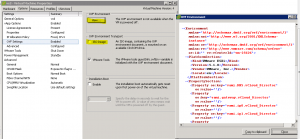This post is also available in: Italian
Reading Time: 2 minutesSome of the interesting aspects of the Open Virtualization Format (OVF) are the simplicity in the distribution, the power in the portability, the platform independence (although is not completely platform agnostic) and the ability to add additional metadata used for the configuration or simple to give more information about the OVF package.
It’s also an open standard, proposed and submitted to the Distributed Management Task Force (DMTF) in September 2007 by VMware, Dell, HP, IBM, Microsoft and XenSource.
About the portability there are two different formats:
- OVF: a multi-file distribution
- OVA: a single file (usually compressed) distribution
But more interesting is how is possible configure a virtual appliance during the OVF deployment. During this phase you can pass some custom parameters and then the appliance itself can read them using some specific functions, like:
vmware-rpctool 'info-get guestinfo.ovfEnv'
Those functions use the VMware Tools to read the OVF parameters (for example the required IP) and then auto-configure the applicance.
For more information see also:
Note that it’s possible read those values in different ways: VMware Tools it’s just one, but could be possible also by an ISO image that must contain a single XML file with the exactly content available in the OVF environment tab:
In this way it’s possible deploy those kind of virtual appliance, with an OVF based configuration, also on VMware Workstation, that could import an OVF/OVA file, but could not ask and pass the OVF parameters.



